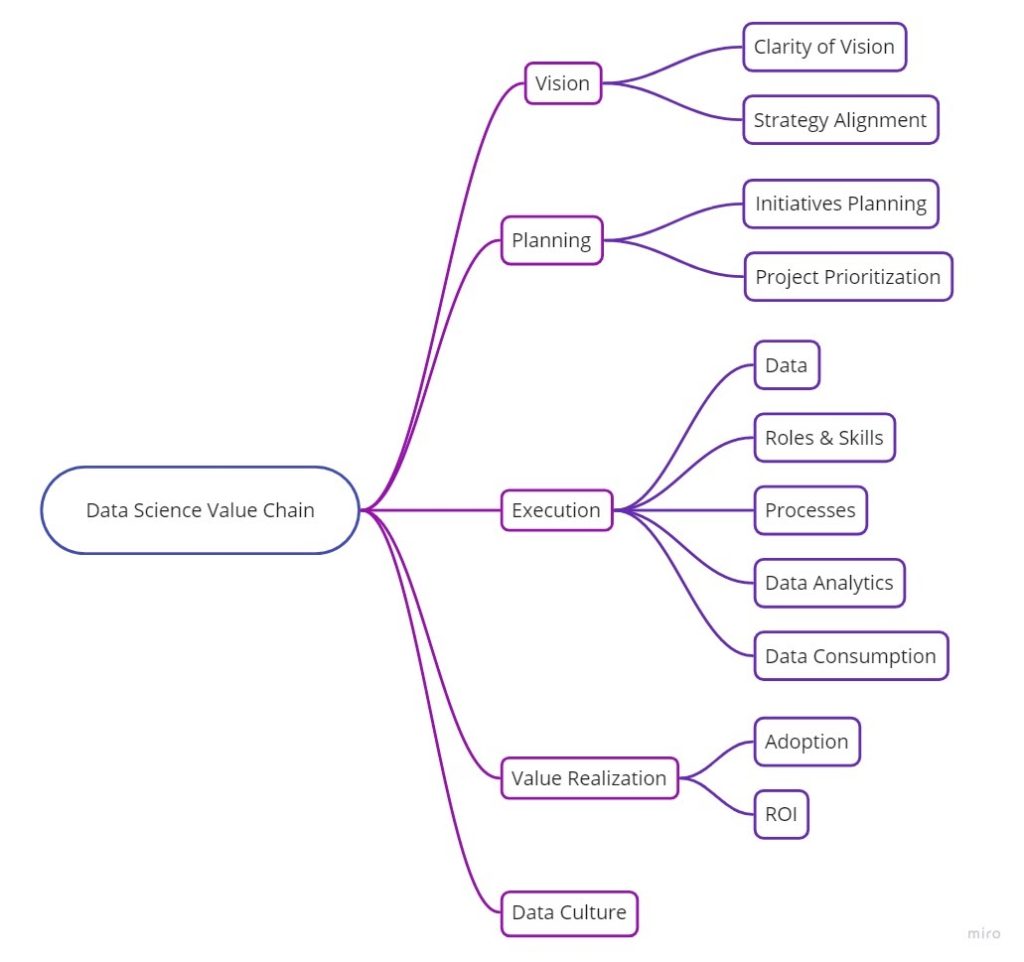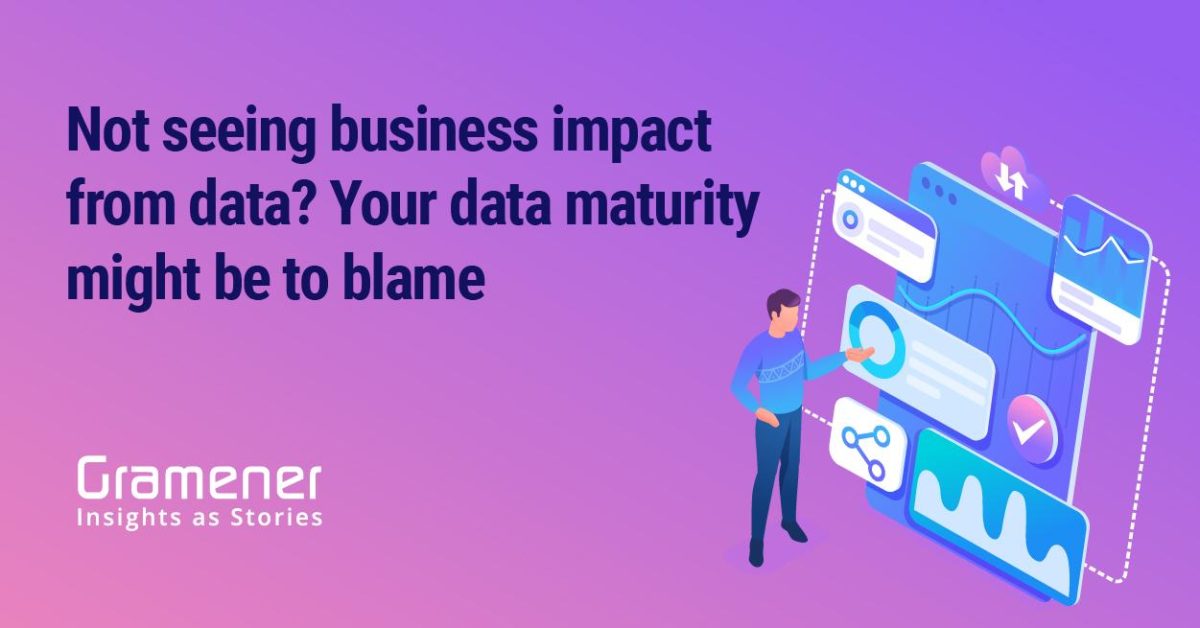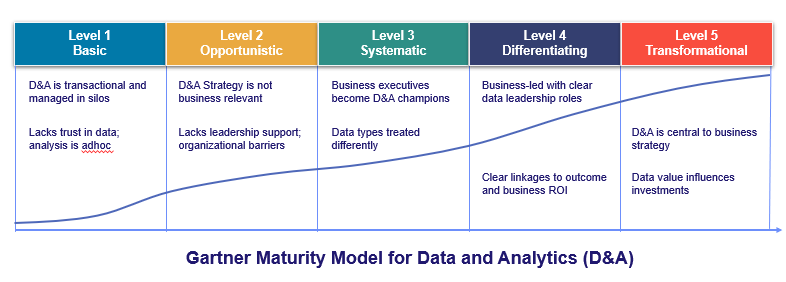Note: This article on Data Science Maturity is co-authored by Ganes Kesari, Chief Decision Scientist, and Sravani Gadhamchetty, Data Consultant at Gramener.
Gartner predicts that, through 2022, around 80% of analytic initiatives will not deliver business outcomes. This shocking statistic implies that most organizations won’t derive value from data science, despite their huge investments.
This can be explained by the narrow focus that most organizations take towards data and analytics. They spend efforts building technical skills and executing projects transactionally rather than architecting organization-wide capabilities for data-driven decision-making.
Most organizations in the industry face this challenge. However, McKinsey found that a small set of enterprises, the data and analytics leaders, excel in using data for decision making. McKinsey reports that the gap between such leaders and laggards is widening.
What are the characteristics of a data-driven organization, and how can you turn your organization into one? To answer this question, you must understand your organization’s data science maturity.
Table of Contents
What is Data Science Maturity and Why Does it Matter?
Data science maturity is a measure of how well a company is able to collect, analyze, consume and adopt data for decision-making across the organization.
The organization can reach high levels of data maturity when data has woven its way deep into the fabric of an organization.
Today, data science maturity directly influences an organization’s performance.
In Deloitte’s Digital Transformation 2020 survey, 45% of companies rated as ‘mature’ from a data and digital experience perspective achieved net revenue growth above industry averages. In contrast, of the companies not rated as ‘highly mature’, only 15% of them achieved this stellar revenue growth.
Gartner says that most organizations evolve through five levels of maturity in their journey with data. Here are the key characteristics of each of the levels:
- Level 1 – Data & analytics capabilities are ad hoc and unplanned. The efforts are primarily siloed across the organization, often leading to multiple versions of the truth. There are pockets of transactional efforts and experimentations to extract business value from data.
- Level 2 – After tasting initial success with data science, individual business units pursue their initiatives. There are some attempts to formalize parts of the process, but the efforts are not standardized and are still restricted to siloes.
- Level 3 – This is the stage where a clear vision for data science emerges, with strong backing from business executives. Standardization starts setting into the teams with a combination of centralized and shared services offered across the organization.
- Level 4 – Data science gets a boost with the addition of data leadership roles such as the CDO (Chief Data Officer) or CAO (Chief Analytics Officer). Teams are performance-oriented and operate with a clear business-innovation framework.
- Level 5 –This is the stage where you embed data science in business strategy and it seamlessly translates into tactical and operational decisions. Your data science teams integrate with the business functions. Data-driven decision-making thrives as a culture within the organization.
How to Assess the Data Science Maturity of Your Organization?
Let’s break down the organizational characteristics from the earlier section into five dimensions. These dimensions span the entire data science life cycle, from the framing of an organization’s vision for data science through the evolution of its data culture.
Here are the five dimensions in the Gramener data science maturity framework, along with an explanation of how they fit into the data and analytics lifecycle:

- Vision – The clarity and focus needed to set goals for data science initiatives in the long term. The extent to which these goals align with larger organizational business strategies.
- Planning – Translation of data science goals into execution plans and a robust short and long-term roadmap. How to carefully pick the individual initiatives for impact and plan them out with milestones.
- Execution – Implementation of the planned data science initiatives by assembling the right data science teams, tools, and processes. Access to pertinent, good quality data that is sourced, transformed and stored effectively. Ability to identify actionable insights by applying the right level of analytics. Enabling consumption of insights through data storytelling.
- Value Realization –Adoption of data science initiatives across the organization. Planning for actionability across milestones with robust measurement of ROI.
- Data Culture – Scaling of data initiatives across the organization. Promoting data literacy across all teams to enable users to make decisions using data.
Assessments that aim to understand organizational maturity in data evaluate their capabilities across these five dimensions. They often do this through questionnaires or interviews with key technology and business stakeholders.
How Can Data Science Maturity Help Your Organization Level Up?
Data science maturity scores can help organizations not just understand their individual gaps and strengths but are also useful in benchmarking their capabilities against the industry. For example, a Gartner report says that 87% of organizations in the industry were in levels 1 & 2 of data science maturity.
The International Institute of Analytics (IIA) published a report with a ranking of analytics maturity scores across industries. For example, organizations in the Financial Services industry had scores in the range of 3.5 to 4.0. Whereas, those in the Insurance industry scored lower, in the 2.3 to 3.1 range.
Finally, it is important to understand that the assessment scores and typical characteristics are meant to be broad indicators. The specifics will vary across industries and organizations, based on the individual scenarios, technology footprint, and business needs. However, when we combine these scores with interviews and in-depth reviews of organizational practices, it can help uncover gaps and plan targeted actions.
The recommendations can enable organizations to chalk out a set of initiatives to pursue in the short, medium, and long-term. Planning such improvement initiatives across the five dimensions will help organizations build all-around capabilities to improve maturity and deliver business value from data.
Transformation Through Improvement in Data Science Maturity
In summary, organizations that understand the concept of data science maturity and take steps to evaluate their capabilities can make a great start in their journey towards business value from data.
At Gramener, we work with top executives to help them transform into a data-driven organization. With our data science consulting and a variety of data advisory workshops, we lay a successful data science roadmap by assessing the level of data maturity of the organization. Take a free assessment and find out where does your organization stand in the levels of data maturity.


